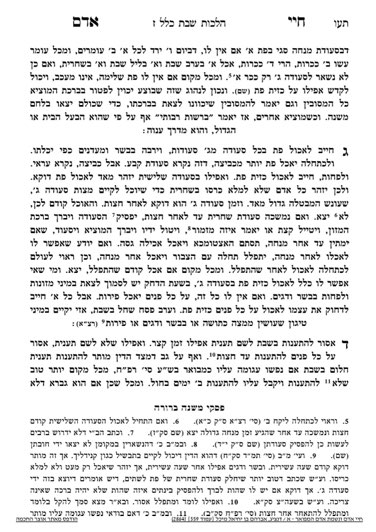The current series, which will cover seudos Shabbos and fasting on Shabbos, is available for sponsorship. Please contact Rabbi Reingold for more information.
We are beginning siman 3. The Chayei Adam writes that the definition of a seudah includes bread, and therefore one is chayav to eat bread at all three seudos. Although, possibly one may be yotzei shalosh seudos without bread, the primary opinion is certainly that one must eat bread.
The Chayei Adam continues, and writes that one should honor the seudah to their abilities, by having meat, fish or other items which are appropriate for them and which they will enjoy.
Chazal understand that the definition of a meal is having more than a k’beiah of bread. Chazal refer to this amount of bread as a seudas keva, a set meal. In a similar vein, we know that before a person is about to perform a mitzvah, they are not allowed to eat more than a snack. The definition of a snack is eating a k’beiah or less, and is known as a seudas ara’i. Thus, lechatchila, on Shabbos, when a person is supposed to be koveah seudah, they should eat more than a k’beiah. Eating only a k’beiah or less is not considered kevah, and is considered more of a snack than a meal.
Nevertheless, if one is unable to eat that amount of bread (whether because they do not have so much available, or because they are unable to eat so much), they must minimally eat a kezayis.
The Chayei Adam writes that one should make a strong effort to eat bread by shalosh seudos as well. A person should also be careful not to overeat at the morning seudah such that they are now unable to eat the proper amount of bread by shalosh seudos. A person should plan ahead and leave room to fulfill their chiyuv of shalosh seudos.
Summary
- A person should make the Shabbos seudos into seudos keva by eating more than a k’beiah of bread at each meal, including shalosh seudos. If one is unable to eat a k’beiah, they must minimally eat a kezayis.



